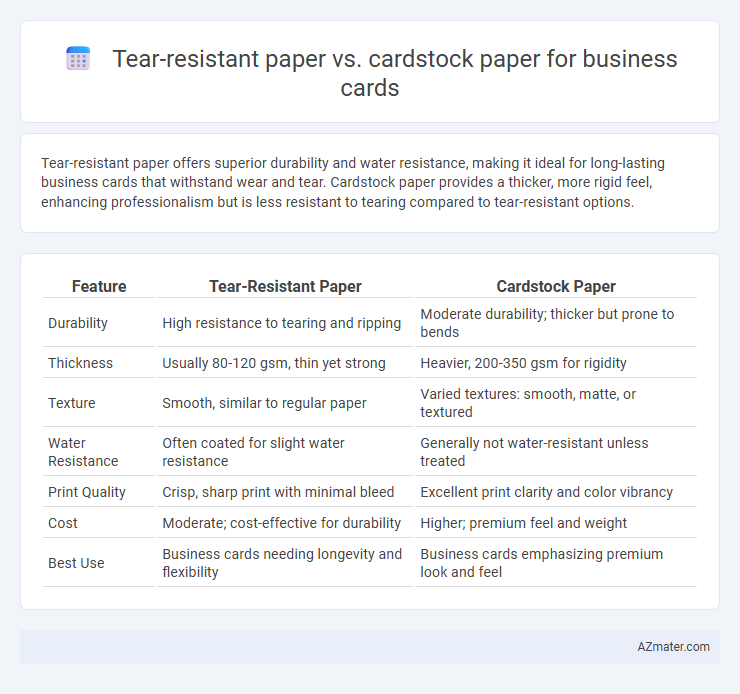Tear-resistant paper offers superior durability and water resistance, making it ideal for long-lasting business cards that withstand wear and tear. Cardstock paper provides a thicker, more rigid feel, enhancing professionalism but is less resistant to tearing compared to tear-resistant options.
Table of Comparison
| Feature | Tear-Resistant Paper | Cardstock Paper |
|---|---|---|
| Durability | High resistance to tearing and ripping | Moderate durability; thicker but prone to bends |
| Thickness | Usually 80-120 gsm, thin yet strong | Heavier, 200-350 gsm for rigidity |
| Texture | Smooth, similar to regular paper | Varied textures: smooth, matte, or textured |
| Water Resistance | Often coated for slight water resistance | Generally not water-resistant unless treated |
| Print Quality | Crisp, sharp print with minimal bleed | Excellent print clarity and color vibrancy |
| Cost | Moderate; cost-effective for durability | Higher; premium feel and weight |
| Best Use | Business cards needing longevity and flexibility | Business cards emphasizing premium look and feel |
Introduction to Tear-Resistant and Cardstock Paper
Tear-resistant paper offers enhanced durability through synthetic fibers and coatings, making it ideal for business cards that withstand frequent handling and environmental exposure. Cardstock paper, known for its thickness and rigidity, provides a classic, sturdy feel but is more prone to tearing under stress compared to tear-resistant options. Choosing between tear-resistant and cardstock paper depends on the desired balance between longevity and traditional texture for professional business cards.
Key Characteristics of Tear-Resistant Paper
Tear-resistant paper for business cards features enhanced durability through synthetic fibers or polymer coatings that prevent easy tearing, making it ideal for long-lasting cards exposed to frequent handling. Unlike cardstock, which is thicker and rigid but prone to ripping under stress, tear-resistant paper maintains flexibility while resisting damage from folds and creases. Its smooth surface supports high-quality printing, ensuring vivid colors and crisp text that convey professionalism in densely circulated business materials.
Key Features of Cardstock Paper
Cardstock paper for business cards offers exceptional thickness and rigidity, typically ranging from 80lb to 110lb cover weight, providing a professional and durable feel. It features a smooth or textured finish that enhances ink absorption for vibrant, high-quality printing with sharp details. Unlike tear-resistant paper, cardstock maintains structural integrity under handling, making it ideal for long-lasting, impactful business cards.
Durability: Tear-Resistant vs Cardstock for Business Cards
Tear-resistant paper offers superior durability for business cards, resisting rips and physical damage better than traditional cardstock. Cardstock paper, while thicker and sturdy, is more prone to tearing under stress or sharp bends. Choosing tear-resistant paper ensures longevity and maintains a professional appearance even with frequent handling.
Print Quality and Finish Comparison
Tear-resistant paper offers a durable surface ideal for business cards needing longevity and resistance to wear, maintaining print quality without smudging due to its robust coating. Cardstock paper provides a thicker, heavier finish that enhances color vibrancy and sharpness, resulting in a professional and tactile print quality favored for premium impressions. When comparing finish, tear-resistant options typically feature a matte or satin finish that resists fingerprints, while cardstock excels in glossy or textured finishes that elevate visual appeal and tactile sensation.
Thickness and Feel: User Experience
Tear-resistant paper offers a smooth yet flexible feel with moderate thickness, providing durability without bulkiness, ideal for business cards subject to frequent handling. Cardstock paper is significantly thicker and stiffer, delivering a premium tactile experience that conveys professionalism but may feel heavier and less pliable. Users often prefer cardstock for its substantial hand-feel, while tear-resistant paper balances resilience and comfort for everyday use.
Cost Differences and Budget Considerations
Tear-resistant paper typically costs more than standard cardstock due to its enhanced durability and specialized coating, impacting overall business card production expenses. Cardstock offers a more budget-friendly option with sufficient sturdiness for everyday use, making it suitable for large print runs on tighter budgets. Choosing between the two depends on balancing the desired longevity of the business card against available budget constraints and cost per unit.
Environmental Impact and Sustainability
Tear-resistant paper for business cards often incorporates synthetic fibers or coatings that increase durability but can hinder recyclability and biodegradability, posing environmental challenges. Cardstock paper, especially when sourced from recycled materials or certified sustainable forests, offers a more eco-friendly option due to its natural composition and easier recycling processes. Choosing cardstock with eco-certifications like FSC or using post-consumer recycled content significantly reduces ecological impact compared to synthetic tear-resistant alternatives.
Best Use Cases for Each Paper Type
Tear-resistant paper is ideal for business cards that require durability and resistance to wear, making it perfect for outdoor events, trade shows, and frequent handling. Cardstock paper offers a thicker, more rigid feel suited for professional presentations, high-end branding, and situations where a premium tactile impression is desired. Choosing tear-resistant paper enhances longevity, while cardstock provides a classic, sturdy presence to elevate brand perception.
Conclusion: Choosing the Right Paper for Your Business Cards
Tear-resistant paper offers enhanced durability and longevity, making it ideal for business cards intended to withstand frequent handling and environmental wear. Cardstock paper provides a thicker, professional feel that conveys quality and solidity, suitable for impactful first impressions. Selecting between tear-resistant and cardstock paper depends on whether durability or tactile premium quality better aligns with your branding and usage needs.

Infographic: Tear-resistant paper vs Cardstock paper for Business card
 azmater.com
azmater.com